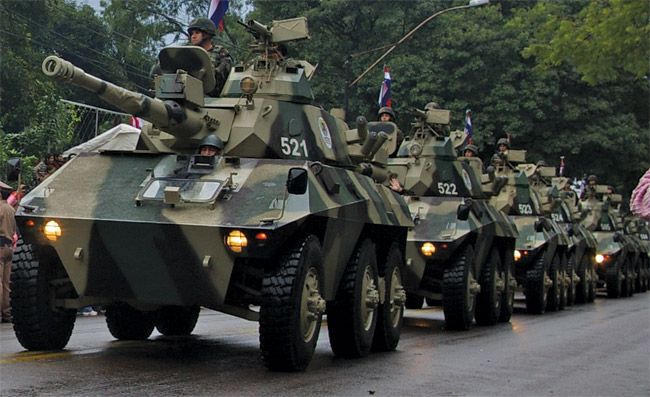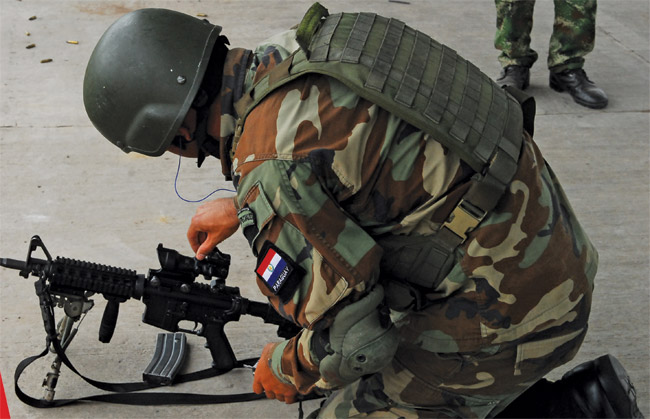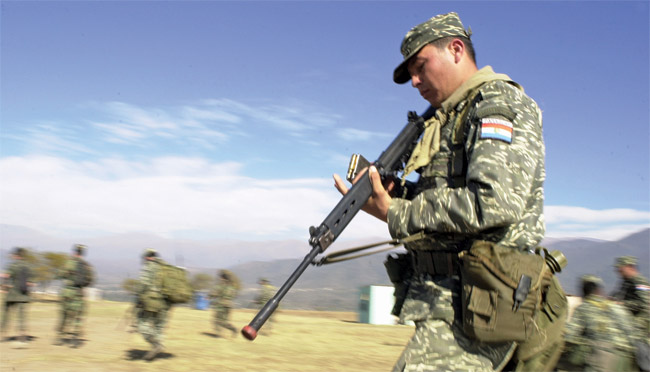Political Debacle
The departure of Lugo resulted in a purge of the Police and Armed Forces and the appointment of a new Defense Minister. Given the situation in South America, and the particular political position of Bolivia leaning in favor of the Socialist Venezuela, or perhaps given the large military lineage of Paraguay, the military modernization program has become very ambitious. This could change now with the death of Hugo Chavez, but this would take some time to be determined, and the Paraguayan government has been investing in the infrastructure as well as new materials for the last three years. Considerable assistance appears to be coming from the U.S., although not to the level desired by the Paraguayans. It had been reported, for instance, that the U.S. was willing to supply funds for the purchase of some five L159 aircraft, but this has not materialized. Nevertheless, the U.S. is likely to provide certain equipment, to include M113 and up-armored Humvees, and considerable motorized equipment continues to arrive, particularly from Brazil and Europe.
The main elite military outfit is the Immediate Action Joint Detachment (DECEI – Destacamento Conjunto de Empleo Inmediato) under the Special Army Troops Command (TEE – Comando de Tropas Especiales de Ejercito), based at Cerrito. In addition to the DECEI, the CTE comprises a Combined Special Forces Battalion (BCFE) and the Formation School. The BCFE was established in 2007, but its official organization was approved on August 24, 2009, by Executive Decree 2764. There are reports that these elite outfits are financed by the U.S., and indeed, in excess of $1.5 million have been donated thorough the U.S. Embassy in Asuncion. However, these troops have also received other equipment, such as 200 CQ-M4 Carbines manufactured by North China Industries Corp. (NORINCO). These are Chinese copies of the Colt M4, chambered in 5.56x45mm, with an action identical to the M16, gas operated, and with a rotating bolt system. The only visible differences between CQ and the U.S. model is that the Chinese variant uses a different shape of pistol grip, and different handguard and buttstock.
There are reports since 2009 that the elites have been reorganized into the new Paraguayan Special Forces Corps (FEP), but this has not been confirmed. The Navy fields its Naval Infantry, distributed into a Command Company, and three riflemen companies (Asunción, Rosario and Vallemí), supported by a service battalion. There is also a small Amphibious Commando (COMANFI – Comandos Anfibios), trained by the U.S. SEALs. The Air Force (FAP) deploys its Silvio Pettirossi Paratroop Brigade, which is in reality a small Infantry Battalion in charge of base security, and having a jump capacity. The military elites are complemented by the Palace Guard (Regimiento de Guardia Presidencial) and the Anti-Terrorist Company. A separate elite outfit is the SENAD (Secretaría Nacional Antidroga), responding directly to the presidency. The SENAD was established under National Law No. 108, passed on December 7, 1991. This Antidrug Secretariat fields the Antidrug Special Forces (FEA – Fuerzas Especiales Antidrogas), established at Tacumbú, and now with HQ in Asunción. Another antidrug outfit functioning under the SENAD is the Antidrug Operations Directorate, established in July 2002, after its operators had attended training in Argentina, Bolivia, Brazil, Germany and the UK. Additional field training came from the USSF and SEALs. There are two other groups that have been mentioned as part of the antidrug and military elites, such as the Phoenix Group and the Anti-Kidnapping Department, but little or nothing is known about them.
Police Spearheading Fight
Among the government forces KIAs in mid-June 2012 were commissioner Erven Lovera, chief of the police Special Operations Group (GEO – Grupo Especial de Operaciones), slain along with his second in command, Osvaldo Aníbal Sánchez Díaz. Soon after their deaths, the government supplied the GEO with Colombian made Galil rifles acquired from Indumil. The GEO is a regional commando organized to the lines of the FOPE, and based at Ciudad del Este.
The FOPE refers to the Paraguayan National Police’s commando, denominated Special Police Operational Force (Fuerza Operativa de la Policía Especializada). Its HQ is at Asuncion, and acts as a SWAT and reaction entry team. However, given the present situation, both FOPE and GEO elements have received COIN (COunter INsurgency) training, and dispatched to fight the insurgent EEP. The Police have also received Huey-II helicopters, and at last one C-212 aircraft to support such operations. In 2010, the government ordered 450 Galil rifles from Indumil (Colombia), specifically to equip the FOPE, followed by additional examples to supply the GEO. Today, the FOPE spearhead the government COIN efforts around Agua Dulce, a region north of Asuncion at Alto Paraguay. The FOPE functions in groups of 10 operators and a leader. All candidates to the FOPE are volunteers who attend almost a year of training before becoming fully operational. The FOPE responds to the police Tactical Support Division. In addition to some 1,000 Galils, the FOPE and GOE have received 10 MGL, shotguns, and Taurus pistols.
It is important to point out that Paraguay has been the center of continuous controversy regarding drug trafficking and other problems. The Brazilian Federal Police has reported several shoot outs with Paraguayan forces while chasing drug traffickers close to the border. Local news also speaks of an increasing arms trafficking within Paraguay, and to neighboring countries. For instance, there were charges that the Australian publication Sydney Morning Herald pointed to the Paraguayan Perfecta SAMI as an illegal arms enterprise. These reports indicated that quantities of ammunition and AK-47s had been moved by said company or affiliates. The trade included assault rifles, and grenade launchers. By December 2012, the chief of the War Material Direction, Óscar Villagra, acknowledged that huge quantities of unregistered weapons existed in the country, to include automatic small arms, and these were found particularly along border cities of Ciudad del Este and Pedro Juan Caballero.
Aftermath
Paraguayans point to a close relationship between their military and the U.S. counterpart, with frequent joint exercises between Paraguayan units and elements of the USSF, USMC and U.S. SEALs. It is noted that at the time of the “coup,” elements of the U.S. Special Operations Command South (SOCSOUTH) Civil Affairs, assisted Paraguayan Military Civil Affairs officers and Paraguayan National Police units with medical attention and education to rural areas, providing medical attention to some 2,400 peasants from Arroyito, District of Horqueta, Department of Concepcion, and in an operation overseen by General Gonzalez, Paraguayan 4th Army Division commander. A month later, a group of U.S. generals reportedly visited Paraguay to discuss the possibility of building a military base in the Chaco region. This is an isolated region bordering with Bolivia in western Paraguay.
Among other things, the Mariscal Estigarribia Military Base, some 250 km from Bolivia, now sports an improved runway that is almost 3.8 km long servicing an almost non-existent air force.
But returning to those dark days in June-2012, as a response to the reverse at Curuguaty, President Fernando Lugo ordered the Army to occupy the region. The action came a little too late, and a political chain reaction followed. The President was blamed for the loss of all 17 and forced to step down passing the government to the hands of vice-president Federico Franco. Politicians claimed Constitutional Article 225 to depose Lugo, and this after the Executive lost all political support. The new Paraguayan government called to new Presidential elections by April 2013.










